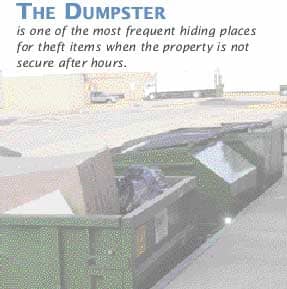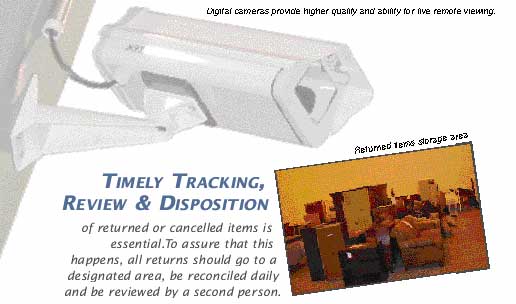This problem never goes away... so don’t turn your back!

Could these situations happen at your facility? An off duty undercover officer buys some furniture at your Outlet Center and drives around back in his pickup. The on-duty warehouse employee loads the purchased items and offers additional furniture for pennies on the dollar. He says that management has no idea what they have in the warehouse and he can get the officer almost anything he wants. The sting results in arrests. This incident occurs because the store didn't use the most basic functions of its state of the art inventory system. Specifically, no consistent cycle counting was performed, and the store's annual inventories hadn't been reconciled for several years.
In a second instance, the police arrests a delivery team because it has been using company trucks to sell and deliver drugs while on the clock. Subsequent review quickly discloses that this team has been running up huge amounts of overtime without being questioned by supervisors and were seen flashing rolls of money in the break area. It is also discovered that your dispatcher has been romantically involved with the team's driver. Company trucks have GPS tracking systems that show where the truck went off route and for how long it stopped. Simply put, management wasn't paying attention.
These true stories would never have come to the attention of management if outsiders had not become involved. Theft by employees is a far greater problem than thefts by outsiders. The University of Florida's 2002 National Retail Security Survey reported that total inventory shrinkage approached 32 billion dollars. Employee theft was 15 billion dollars, while shoplifting was 10 billion dollars. Administrative errors totaled 5 billion and vendor fraud was 2 billion. Minimizing the risk isn't rocket science, but requires attention to the basics of warehouse management and controls. Safeguards can help your business avoid these losses.

Theft of goods is on the rise in furniture retail establishments nationwide. All too often, our routine management reviews disclose similar situations. Most of your products are easily sold by thieves or are stolen by employees to meet specific requests from their friends or associates, or even to furnish their own houses! Since you cannot operate your warehouse like a bank vault, what steps can you take to protect your investment?
Your first line of defense is to make sure that one individual doesn't control receiving, inventory, disbursements and adjustments. Be especially aware of the trusted employee who works long hours and never takes a vacation. You probably trust your bookkeeper, but just to play it safe, as a good business practice, bank statements should be mailed to the owner's home for personal review for non-existent service contracts, vendors and credits.
Mass thefts where thieves hijack a truck or break into a warehouse are rare. Pilferage or disappearance is more common. Pilferage may involve collusion between truck drivers and warehouse people who receive less than the full quantity of material off an inbound shipment or load "extra" products on the truck when shipping. They may also load the orders obtained through their fellow thieves employed as sales people. There are multiple ways to defend against theft and pilferage. One is a combination of physical deterrents and systems that make it difficult to break security. Another defense is to attempt to confirm the honesty of your employees.
ELECTRONIC SECURITY
Electronic warehouse security systems to protect your building when it is unoccupied can be supplied by a wide range of devices. These include window and door monitors, movement sensors, sonic alarms and even closed loop video cameras. Possibly even more important is external security. Adequate lighting of exterior walls ensures that thieves don't have the cover of darkness in your parking lots and dock areas. You may also consider a gate to prevent access to the rear of the building. Whenever possible, employee parking should not be against the building.
The ability to remotely access your digital video security system via an Internet connection to your computer at any hour of the day and night is a great tool.
EMPLOYEE HIRING
Management's lack of concern for security is a major factor in thefts by warehouse and delivery people. A primary cause of theft is poor attention to the value of pre-employment screening. Personal interviews, drug screening, reference checks and criminal background reviews all have merit. The absolute minimum is a series of phone calls to verify employment dates and to ask whether previous employers would rehire your applicant. Expect some companies to only disclose the dates of employment and the job title in today's “sue everybody” environment. You therefore, may want to use honesty tests that disclose attitudes of people who are likely to steal. These tests typically take less than an hour, can be scored quickly and are low cost.
MANAGEMENT VIGILANCE
Management can also reduce the risks of employee theft by driving around the back of the building when coming and going, checking the dumpster and walking through the warehouse at random times. Insist that your managers do the same. It takes so little time but shows employees that you are alert. Cycle counting and periodic inventories are essential.
Multiple warehouses present an easy opportunity for easy thefts when they are not manned full-time and when many employees have keys.
RECEIVING
Some thefts occur through a joint effort of warehouse receiving staff with vendors, trucking or shipping personnel. Receiving counting requires absolute accuracy. Many retailers receive from a copy of the purchase order and mark off the count received and also count off from the carrier's packing list. The receiving tally is the start of the audit trail. This document must contain the required information plus any exceptions such as overages, shortages and damage discrepancies. These must be noted and fully documented. Always count twice before signing once!
When everything is processed, all the receiving paperwork should be clipped together and sent to accounting to be matched with the invoice, freight bill and original purchase order terms. Receiving is both a material handling and auditing process. Bottom line, you must know you have the material ordered, the quantity ordered, items received within an acceptable time frame, acceptable quality and an accurate record of the transaction. Today's bar coded warehouse management systems have numerous features that provide control... but they are only effective when they are used consistently. Any remaining bar code labels must be turned in with the paperwork.
It may become necessary to use undercover contract employees to detect serious thefts by your employees. Undercover employees can help to inform you about on-the-job drug sales and other illegal enterprises.
DELIVERY
When goods are staged for delivery, everything should have corresponding tags matching the truck manifest to assure that only the correct merchandise is loaded. Some retailers use fenced cages to isolate the stock going on a particular truck.
Delivery trucks may be followed to assure they stay on route and on time. An electronic way to track vehicles is with GPS units similar to the OnStar system you may have in your car.
A favorite tactic with identity theft perpetrators is to make major purchases with credit cards as customer pickups. You should record the license number of every vehicle making a customer pickup and note the vehicle make.
RETURNED GOODS
Review how you handle returned goods. Many furniture retailers' procedures are inadequate.
For example: An entertainment center is picked up from the customer and never makes it back into inventory. There are several possibilities.
- It makes it back to the store and even though it is fully satisfactory, it is written off as scrap or consigned to donations.
- It may have been entered into inventory but was actually dropped off somewhere else on the way back. If you have the same person picking up the unit and entering it back into inventory, your risks are increased dramatically. The lost unit will only show up when you are out of stock or take inventory. Then it will probably simply be written off as a discrepancy.
To prevent this from happening, all returns should go to a designated area, be reconciled daily and be reviewed by a second person.
Bottom-line, maintain adequate controls and take time to walk the warehouse and check the facility outside regular hours. Most of all, hire the most honest people you can find, yet maintain a healthy skepticism that they will always be honest.
DOs & DON'Ts Of Employee Theft Prevention*
Always...
- Be completely honest with your employees and customers. Management must set a good example.
- Make sure that all employees are aware of the rules of the business.
- Always check employees' reported hours before you sign their timesheet. Make sure that the employees have worked the hours they are reporting.
- Act on any suspicious feeling that you have toward an employee. Make sure that your suspicion is reasonable.
- Make sure that the employee parking lot is not close to the building. You don't want it to be convenient for them to move things out of the business.
- Monitor cash transactions as often as possible.
- Act off another employee's hunch or gossip.
Never...
- Be too busy to monitor employees regularly.
- Allow employees to handle their own transactions (when they purchase things for themselves).
- Wrongly accuse an employee of theft. Make sure that accusations are investigated before you have a serious meeting with the employee.
- Allow a lot of time to pass before you look into suspicious activity. The longer you wait, the more money you will probably lose.
Contributing editor Dan Bolger of The Bolger Group helps companies achieve improved transportation, warehousing and logistics. You can send inquiries on any aspect of transportation, warehousing or logistics issues to Dan at dbolger@furninfo.com.
Resources:
http://retailindustry.about.com/od/statistics_loss_prevention/l/aa011124a.htm (University of Florida)
* Dos and Don'ts of Employee Theft Prevention compiled by Professor Marcus Felson, Rutgers University and Professor Sharon Chamard, now at the University of Alaska, Anchorage can be found at http://crimeprevention.rutgers.edu/crime/emp_theft/emp_theft.